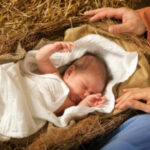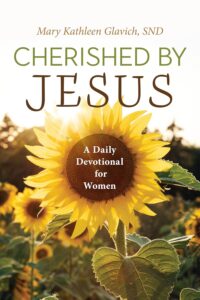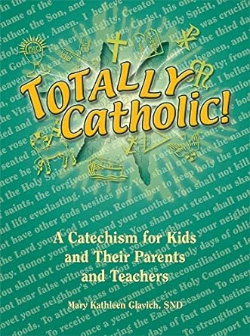 To celebrate Christmas, here are excerpts from the chapter “Manger” in my first published (and republished) book Voices: Messages in Gospel Symbols.
To celebrate Christmas, here are excerpts from the chapter “Manger” in my first published (and republished) book Voices: Messages in Gospel Symbols.
Jesus could have been born at home in Nazareth and placed in a wooden crib fashioned by his carpenter-father, Joseph. Instead, because he makes his appearance while his mother and father are en route, he has no suitable place to lay his head. This circumstance is prophetic, for over thirty years later, as an itinerant preacher, he will claim, “Foxes have holes and the birds of the air have nests, but the Son of Man has nowhere to lay his head” (Matthew 8:20).
A manger is a feeding trough for animals. The French word manger means “to eat.” In the stable where Joseph and Mary are forced to stay, the manger serves as a makeshift crib for their baby, the Redeemer. God’s propensity for foreshadowing comes into play here. Not only is Jesus, our Live-Giver, laid in a feeding place, but his birthplace is Bethlehem, a town whose name means “House of Bread.” It is as though God goes out of his way to underline that he is Bread for the world.
Eating is as essential to life as breathing. Daily we refuel ourselves with food. Omitting meals for any length of time leaves us weak and malfunctioning. No wonder that we pray in the Our Father, “Give us this day our daily bread.” We look to God for life. When Jesus spends his first hours in a manger, he indicates that he is our bread, our life. Without him we can’t survive. Interestingly, D.T. Niles in That They May Have Life defines evangelization as “one beggar telling another where to find bread.”
As Jesus’ journey on earth begins with wood, so does it end—not with the warm, welcoming wood of the manger, but with the rough wood of the cross. This wood, too, is associated with bread. The Body of Jesus nailed to the cross made efficacious his words of the preceding evening when he held bread in his hands and declared, “This is my Body.” The cross is the wood through which he becomes our life.
When Jesus held the crowd’s rapt attention for hours and they grew hungry, he astounded them by multiplying bread in abundance. Jesus continues to feed the hungry through his church. One of the first decisions his followers made was to appoint deacons to oversee the distribution of food to the needy.
Today Jesus still nourishes people in the form of bread. Whenever we share in the Eucharist, we are energized for our particular journey on earth. As really as he rested in the manger on Christmas night, as really as he hung on the cross on Good Friday, Jesus comes to us when we partake of the sacrament. He unites himself with us, and we become like him. But becoming like him means we become bread for others.
Being bread for others means having compassion on them in their hungers. When someone hungers for attention, we are there to listen. When someone hungers for affirmation, we are their to encourage and support. When someone hungers for understanding and sympathy, we are there to give solace. Where someone hungers for justice, we are there to set things right. In the words of Caryll Houselander, “The ultimate miracle of Divine Love is this, that the life of the risen Christ is given us to give to one another, through the bread of our human love.” Blessed Mother Teresa of Calcutta told her novices, “Let the people eat you up!”
The manger brings to mind hospitality. It receives the child when the inns are closed to him. The child grows up to become the greatest and most gracious host the world has known. At the outset of his ministry two of John’s disciples stay the afternoon at his house. After the resurrection, he grills fish on the shore and serves his disciples breakfast. His doors are open to everyone: the poor, the lonely foreigners, lepers, all those whom society ignores and scorns. He makes them feel welcomed and relaxed. He gives them back their dignity. He requires a like hospitality in us, his followers, revealing that we will be judged on the way we receive the hungry, the thirsty, the naked, the stranger, the sick, and the imprisoned. Jesus was all of these when he came into the world at Bethlehem. He was all of them when he left it. He is all of them today in his brothers and sisters.
As a newborn babe, Jesus was hungry, thirsty, naked, and weakened from the ordeal of birth. He was a stranger in Bethlehem, and his divinity was imprisoned in flesh. On Calvary, Jesus was hungry and thirsty from the loss of blood, and he was naked. He was weakened from torture. He was a stranger and outcast in Jerusalem and had been imprisoned.
Most obviously the manger symbolized poverty. God certainly could have planned a more plush setting for his entrance into the world. Somehow, though, the stable with its smells, rude crib, earthiness, and simplicity is right. Jesus identifies with the poor and lowly. His mission is to the bring the good news to the poor. (Luke 4:18)
When the Holy Family departed from the stable, the manger became a common trough again. But thanks to St. Francis of Assisi, who initiated the custom of setting up the creche at Christmas, the shining moment of the manger is remembered each year.
Do you set up a nativity scene in your home? Does your church have one? What nativity set has meaning for you? I once stayed for a couple of months at the Shelter of God’s Love in Chicago. The community of disabled people who lived there prayed together every night. In their dining room a crib with Baby Jesus was displayed all year. Visitors placed their intentions in it.









